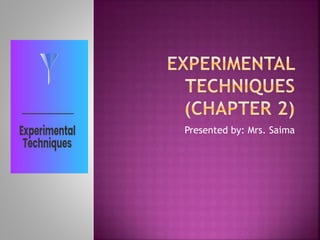
Experimental techniques -choosing appropriate equipment for mass,volume and temperature
- 1. Presented by: Mrs. Saima
- 4. 2.1 Measurement • Name appropriate apparatus for the measurement of time, temperature, mass and volume, including burettes, pipettes and measuring cylinders 2.2 Purity Methods of purification • Describe and explain methods of purification by the use of a suitable solvent, filtration, crystallisation and distillation (including use of a fractionating column). (Refer to the fractional distillation of petroleum and products of fermentation) • Suggest suitable purification techniques, given information about the substances involved
- 5. A solution in chemistry is a homogenous mixture of two or more substances. The substance which is dissolved is called a solute. The substance in which the solute is dissolved is called a solvent. The maximum amount of solute that can dissolve in a known quantity of solvent at a certain temperature is its solubility. A pure substance would be made of a single substance and is not mixed with something else eg. pure water, gold which is not mixed with something else An impure substance has two more substances mixed together eg. mixture of salt and sand. Suspension is when a solute is not homogenised with a solvent and its particle
- 7. Purity assessment from melting point/boiling points The melting point of a substance is the temperature in which the substance melts. Similarly, the boiling point of a substance is the temperature at which it boils. Interestingly, the boiling point and melting point of a substance can give us an indication of how pure it is. The table below summarizes this quite well
- 8. A pure substance have definite, sharp melting point and boiling point. These are different for each substance. You can identify a substance from its mp/bp When a substance contains impurity I. Its melting point falls and boiling point rises II. It melts and boils over a range of temperature and does not have a sharp melting point III. Recall heating curves →
- 10. Mass: Scale, balance, top pan balance, digital balance etc Time: Clock, stop watch Temperature: Thermometer Volume: ? Beaker? Measuring cylinder?
- 12. Pipettes and burettes are more accurate than measuring cylinder. Measuring cylinder is quicker and easier If you need to pour something quickly you must use measuring cylinder, If you need an accurate measurement of volume of liquid, pipette or burette must be used. Pipettes are usually used to add a fix volume for example 5,10,25 cm3. Burette can be used for measuring variable volumes of liquids accurately like 11.2 cm3, 21.9 cm3 etc
- 13. Filtration: To remove an insoluble solid from a liquid/solution Decanting : To separate a liquid from insoluble solid Evaporation : To separate a soluble substance (solute) from a solution. Crystallization : To separate a soluble substance (solute) from a solution in the form of crystals. Simple distillation: To separate a solvent (liquid) from the solution leaving behind solute. Fractional distillation: To separate a mixture of liquids from each other on the bases of different boiling points
- 14. Filtration Filtration is carried out by pouring the mixture into a funnel covered by a filter paper. Whilst the liquid will pass through the filter, solids will get caught, thereby separating them.
- 15. Decanting is the simple process of letting insoluble solids settle in the liquid before gently pouring it out later.
- 16. This is a simple process of separating a solute from a solution. Simply let the solvent evaporate off and it will leave the solids behind. Solution is heated in an evaporating dish over a Bunsen burner and tripod until all solvent evaporates, leaving behind the solid solute.
- 17. This technique is used to separate a soluble solid from a solution. It works by heating the solution to crystallisation point and then slowly cooling it. The soluble salt will crystallize on cooling due to decrease in solubility at low temperature.
- 18. 2.1 Measurement • Name appropriate apparatus for the measurement of time, temperature, mass and volume, including burettes, pipettes and measuring cylinders 2.2 Purity Methods of purification • Describe and explain methods of purification by the use of a suitable solvent, filtration, crystallisation and distillation (including use of a fractionating column). (Refer to the fractional distillation of petroleum and products of fermentation) • Suggest suitable purification techniques, given information about the substances involved
- 19. Copy the objectives Copy the questions on topic 2.3 and Answer them. Raise your hand when finished